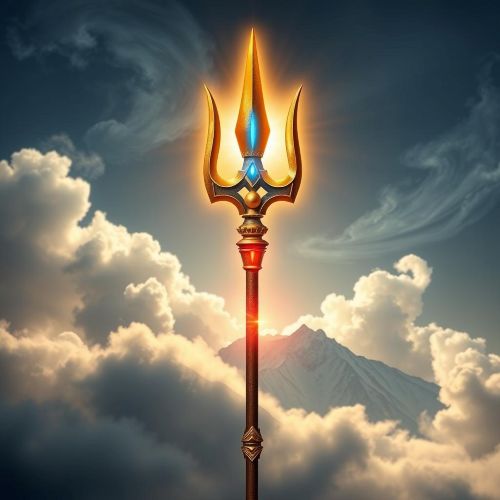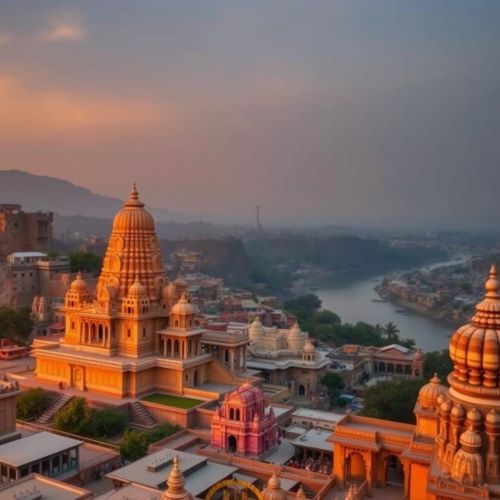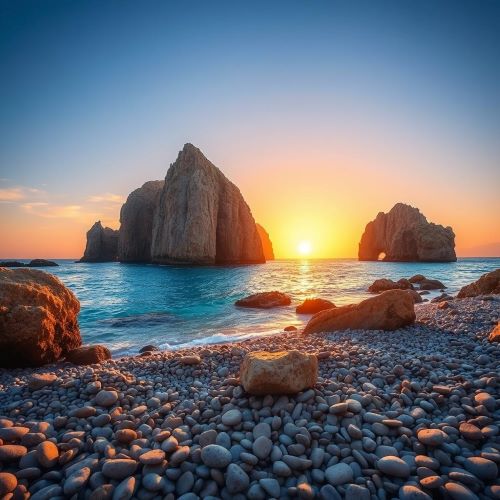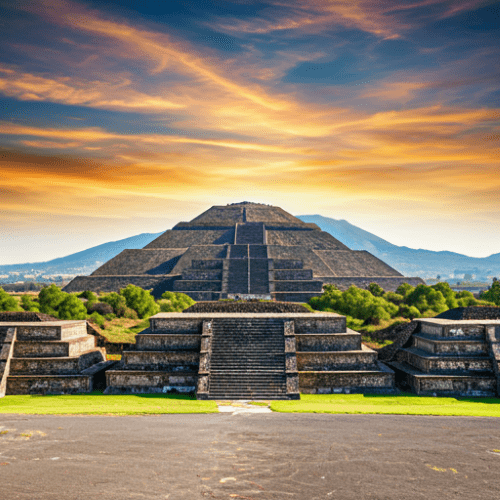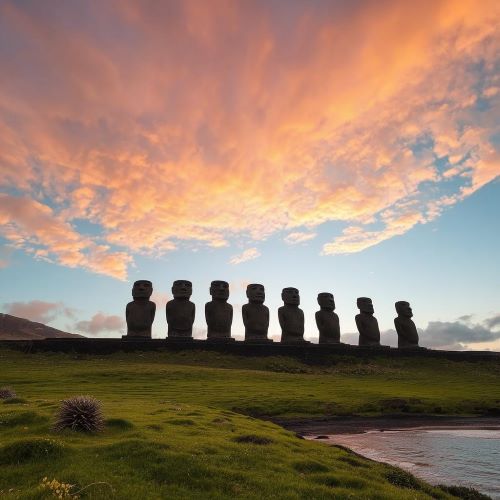Dwarka : Birthplace of Krishna
At a glance
| Description | |
|---|---|
| Mythology | Indian Mythology |
| Country | India |
| Closest airport | Porbandar Airport (PBD) |
| Type | Constructed |
| Accessibility | 10/10 |
Introduction
Dwaraka, nestled along the Arabian Sea in Gujarat, stands as a profound symbol of India’s spiritual legacy. Revered as one of the holiest cities in Hinduism, it’s more than a pilgrimage site—it’s a destination where mythology, history, and serene landscapes converge. The city invites pilgrims and tourists alike to uncover tales of divinity while enjoying its timeless charm, ancient architecture, and vibrant coastal life. Whether drawn by religious reverence or the allure of ancient legends, visitors to Dwaraka find themselves immersed in a unique cultural tapestry.
Connection with Mythology
According to sacred Hindu scriptures, Dwaraka was founded by Lord Krishna himself after he left Mathura to safeguard his people from constant conflict. Built on reclaimed land and crafted by the celestial architect Vishwakarma, Dwaraka became the capital of the Yadava dynasty and served as a sanctuary of peace and prosperity. Descriptions from the Mahabharata and Skanda Purana detail the city’s golden domes, gemstone-studded palaces, and technologically advanced layouts, offering a glimpse into its mythical grandeur.
The most compelling aspect of its legend is the city’s submergence into the sea after Krishna’s departure, marking the end of an era. This myth gained renewed attention through underwater archaeological explorations off the modern-day coast, where divers discovered stone anchors, structural remains, and artifacts that resemble urban planning described in ancient texts. These findings have intensified the belief that the mythical Dwaraka may have been a real city that once thrived thousands of years ago.
Ways to Get There
Reaching Dwaraka is straightforward, thanks to its well-established transport links. For air travel, Jamnagar Airport is the closest hub, situated about 130 kilometers away. From there, taxis and buses offer a convenient ride to the city, typically taking under three hours.
Train travel is equally efficient, with Dwarka Railway Station connected to major Indian cities like Mumbai, Ahmedabad, Delhi, and Vadodara. Regular express and superfast trains make it accessible for pilgrims and tourists from various parts of the country.
For road travelers, the city is well-served by national highways. Buses operated by the Gujarat State Road Transport Corporation (GSRTC), as well as private operators, run regularly from Rajkot, Somnath, and Ahmedabad. Driving by car offers scenic views of Gujarat’s countryside and is often preferred by families and tour groups. The journey to Dwaraka is not just a commute—it becomes part of the spiritual experience.
What to Look For
Dwaraka is home to some of the most spiritually resonant and historically significant landmarks in India. The Dwarkadhish Temple, also known as Jagat Mandir, is the centerpiece of the city. This towering five-story temple dedicated to Lord Krishna showcases stunning Chalukya-style architecture and intricate carvings that narrate tales from Krishna’s life. It is a site of intense devotion, particularly during Janmashtami.
Just a short trip away lies Bet Dwarka, believed to be Krishna’s residential kingdom. Accessible by ferry or via the Sudama Setu bridge, the island holds several temples and archaeological interest points. Another notable spot is the Rukmini Devi Temple, dedicated to Krishna’s consort. This temple is renowned for its detailed sculptures and legends about the divine couple’s life.
On the outskirts of the city, the Nageshwar Jyotirlinga Temple, one of the twelve sacred shrines of Shiva, adds to Dwaraka’s spiritual significance. The Gomti Ghat, a revered riverfront, is where pilgrims take ritual dips before visiting the temples. Nature lovers will enjoy Dwarka Beach, where the gentle waves meet golden sands under vibrant sunsets. The Dwarka Lighthouse nearby offers panoramic views of the Arabian Sea. Altogether, these sites form a comprehensive spiritual and cultural experience for every visitor.
Need a place to stay? Book your hotel room now!
Importance in cultural history
Dwaraka’s cultural footprint extends far beyond its mythological roots. It is one of the Char Dham pilgrimage sites established by Adi Shankaracharya, alongside Badrinath, Puri, and Rameswaram—each representing different spiritual paths in Hinduism. Being part of this sacred circuit gives Dwaraka an unmatched religious stature.
Its role in India’s history is equally intriguing. As a port city in ancient times, Dwaraka was part of maritime trade routes that connected India with Africa and the Middle East. Marine excavations have revealed well-laid foundations and harbor structures that speak to its significance in the Indian Ocean trade network.
Culturally, Dwaraka has been immortalized in devotional music, dance, and literature. It inspired poets like Surdas and Mirabai, whose bhajans about Krishna continue to resonate with devotees. The city is also a hub during Krishna-centric festivals such as Janmashtami and Holi, when its streets come alive with devotional processions, plays, and music. Through centuries of transformation—from mythological grandeur to modern-day pilgrimage hub—Dwaraka has retained its identity as a bridge between the spiritual and the tangible, the past and the present.
Best time to travel
The most favorable time to visit Dwaraka is during the cooler months from October to March. The weather during this period is ideal for temple visits, beach strolls, and exploring nearby attractions, with daytime temperatures ranging from 12°C to 28°C.
While monsoon season (July to September) bathes the city in refreshing rains, travel can be occasionally hampered by slippery roads and limited ferry services to Bet Dwarka. However, the greenery and fewer crowds make it a pleasant time for those seeking a quieter experience.
Summers (April to June) in Dwaraka are typically hot and dry, with temperatures soaring above 35°C. Though the heat can be intense, early mornings and evenings are suitable for sightseeing if you take necessary precautions like staying hydrated and avoiding midday excursions.
If your aim is to witness the city in all its spiritual glory, time your visit with Janmashtami, the celebration of Krishna’s birth. Held in August or September, the festival transforms Dwaraka into a spectacle of lights, music, and spiritual fervor. Thousands of devotees gather, and temples remain open throughout the night, offering an experience that is both divine and unforgettable.
Source
Contributors to Wikimedia projects. (2004). Dwarka – Wikipedia. https://en.wikipedia.org/wiki/
Gujarat Expert Team. (2025). History of Dwarka – Dwarka City Legend Mythology Stories. https://www.gujaratexpert.com/dwarka-history/
Travels and Adventure. (2024). Discover Dwarka: A Journey Through History, Mythology, and … https://www.wonderlustways.com/2024/08/dwarka.html
Dwaraka: The Lost City of Ancient Legends | 01 – Vocal Media. (2023). https://vocal.media/01/dwaraka-the-lost-city-of-ancient-legends
Frequently Asked Questions
Lorem ipsum dolor sit amet, consectetur adipiscing?
Lorem ipsum dolor sit amet, consectetur adipiscing elit. Praesent convallis vestibulum justo, ac tincidunt nunc vehicula quis. Nullam id dolor quis orci malesuada feugiat. Curabitur aliquet libero at urna ullamcorper, ac ultricies nulla dapibus.
Lorem ipsum dolor sit amet, consectetur adipiscing?
Lorem ipsum dolor sit amet, consectetur adipiscing elit. Praesent convallis vestibulum justo, ac tincidunt nunc vehicula quis. Nullam id dolor quis orci malesuada feugiat. Curabitur aliquet libero at urna ullamcorper, ac ultricies nulla dapibus.
Lorem ipsum dolor sit amet, consectetur adipiscing?
Lorem ipsum dolor sit amet, consectetur adipiscing elit. Praesent convallis vestibulum justo, ac tincidunt nunc vehicula quis. Nullam id dolor quis orci malesuada feugiat. Curabitur aliquet libero at urna ullamcorper, ac ultricies nulla dapibus.
Lorem ipsum dolor sit amet, consectetur adipiscing?
Lorem ipsum dolor sit amet, consectetur adipiscing elit. Praesent convallis vestibulum justo, ac tincidunt nunc vehicula quis. Nullam id dolor quis orci malesuada feugiat. Curabitur aliquet libero at urna ullamcorper, ac ultricies nulla dapibus.
Lorem ipsum dolor sit amet, consectetur adipiscing?
Lorem ipsum dolor sit amet, consectetur adipiscing elit. Praesent convallis vestibulum justo, ac tincidunt nunc vehicula quis. Nullam id dolor quis orci malesuada feugiat. Curabitur aliquet libero at urna ullamcorper, ac ultricies nulla dapibus.


